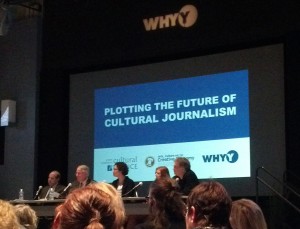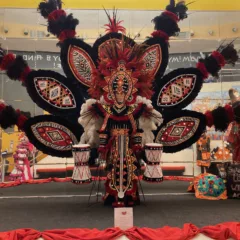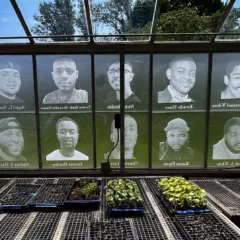Since the economic nosedive sent traditional print journalism into crisis mode, the health and future of culture and arts journalism has been a topic of serious concern, especially in the arts community. The Philadelphia Inquirer, for example, had a twenty percent profit margin in 2000 but by 2012 it had lost seventeen million dollars. These statistics were shared by Bill Marimow, Editor of the Inquirer, at a recent panel discussion, “Plotting the Future of Cultural Journalism” held at WHYY’s Hamilton Commons. Marimow said that newspapers have yet to find a sustainable business model in the current economic climate which includes circuitous or dwindling economic paths and a vast internet for which seventy percent of content is created by users.

One of the first questions addressed by Marimow was about the Inquirer’s dedication to arts and cultural coverage in Philadelphia. Citing the recent re-assignment of theater critic Howard Shapiro to a New Jersey news beat, Marimow explained that since a large percentage of readers hail from South Jersey the paper simply had to rededicate their efforts there. Less clear was an explanation for why visual arts coverage by Ed Sozanski and Edith Newhall will appear now only on alternating Sundays. Rather, Marimow showed the audience a recent Inquirer edition in which several arts and cultural stories appeared, and stressed that the paper is dedicated to doing excellent work within the present economic possibilities.
The round-table discussion made it clear just how challenging the editorial decisions must be in the current, strained conditions. What also shone through was how severe the hits have been to arts journalism in particular. Douglas McLennan, founder and editor at ArtsJournal.com, and keynote speaker at this event, said that since 2000 half to two thirds of the arts coverage nationwide has been lost. He cited many of the aggregated culture sites as one reason for these losses. Readers now seem to forgo long-form film reviews in favor of a quick rating on Rotten Tomatoes, for example, which shows an average of all reviewers aggregated for that particular feature.
Despite the losses to traditional journalism, the internet still proves hopeful as an outlet for dedicated arts coverage. In Philadelphia, as in many major cities, journalists, bloggers, and culture producers support sites which make up for the shortfalls left by newspapers. McLennan mentioned The Knight Foundation, Hidden City, Broad Street Review, artblog, Phawker, and Philebrity as examples of Philadelphia’s thriving sites. And there are several visual arts-specific outlets which remain dedicated to long form reviews or essays such as the Nicola Midnight St. Claire, Inliquid, Machete, and Title Magazine, as well as the many gallery websites that publish interviews or essays to accompany their exhibitions.
McLennan described beautifully how internet-based arts journalism can be a place for creative identity formation and sharing of cultural experiences. Viewing the Mona Lisa, McLennan noted, is not complete without a Tweeted pic, or Facebook update; culture is now shared instantly and not necessarily by professional critics or writers. As such, McLennan advises arts and culture organizations to find a way to build enough creative constituents who can then blog, tweet, and post about their experiences. He said, “build and deepen the community; empower the excellence and resources of the community to be able to work on your behalf.”
Arts writers have created informative and in-depth websites which are now the go-to places for arts reviews. But, what’s lost, according to the experts on this panel, are the “seasoned writers,” arts journalists who can have long-term careers in a supportive environment, make a good living wage, interact with colleagues, and deeply cover a specific beat. Ed Sozanski has been writing about the visual arts in Philadelphia for thirty years. And while there are arts professionals and writers who would be able to match his knowledge about the Philadelphia art scene, it’s the institutional support of this kind of expert professional, with deep and vast familiarity and a lifetime of contacts, that remains at risk today. Also at risk, said McLennan, is serious, professional consideration of areas of culture that so positively impact the quality of life for many but often receive little critical consideration: dance, community arts, participatory choruses, and alternative cultures.
The editors on the panel said that engaging readers about the arts is a particular journalistic skill, like hosting a dinner party. How can you lead a good conversation, provide some details and context, and then get out of the way? This dinner party metaphor describes an ideal for critical discourse about arts and culture, but with traditional journalism in a state of flux, exactly who will be invited and what will be served remains unknown.
Plotting the Future of Cultural Journalism was presented by the Greater Philadelphia Cultural Alliance, the City’s Office of Arts, Culture, and the Creative Economy, and WHYY on February 20. More about the event including a podcast and video can be found here.









